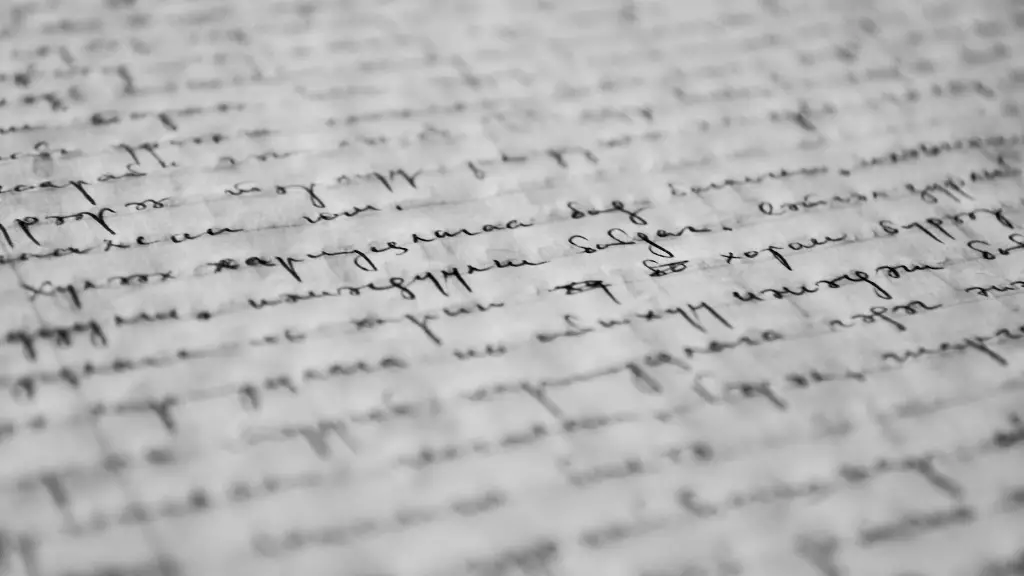Onomatopoeia in Poetry
Parallelism in poetry is the use of similar structure within sentences and phrases to express ideas. It is a technique employed by poets to create a stronger sense of order and organization within their work.
Parallelism can occur in both single lines and longer sections of a poem. It can be used to create repetition of rhythm and sounds, and to emphasize or heighten ideas or emotions.
In single line parallelism, the repetition of words or phrases can convey a sense of completeness and unity. For example, Alexander Pope’s famous poem, An Essay on Man, containing parallel structure in the lines: “Know then thyself,/Presume not God to scan;/The proper study of mankind is man.”
In longer sections of poetry, parallelism can be used for emphasis and for a variety of other purposes. Sometimes, parallelism can be used to draw a contrast between two ideas, as in William Wordsworth’s Line Written in Early Spring, which contains the following poem:
“The rosy blush of morn/The clouds that gather round the setting sun”
The author creates a contrast between the beauty of morning and the gathering clouds of evening.
Parallelism can also be used to express an idea in different ways and to create an emotionally charged response in the reader. Walt Whitman’s famous poem, Leaves of Grass, uses parallel structure in the following lines: “Strong and content I travel the open road/The world before me, the world ahead of me”
The repetition of the phrase “the world” helps to create a feeling of movement and adventure while conveying ideas of exploration, freedom and possibility.
Parallelism can also be used to create a sense of balance in poetry. When sections of a poem contain balanced language patterns, it helps to create a sense of harmony and order. Robert Frost’s Mending Wall is a perfect example of this, with the repeated phrase: “Good fences make good neighbors”
Parallelism can also be used to create a sense of rhythm and musicality, allowing the poet to add musicality to the poem. The repetition of words and sounds can lend a powerful effect and can make the poem more enjoyable to read.
Rhythm in Poetry
Rhythm is an important element of poetry and is often brought out through the use of parallelism. By repeating words or phrases, a poet is able to create a rhythm which can help to capture the reader’s attention and give the poem a sense of unity. An example of this can be found in Langston Hughes’ poem The Negro Speaks of Rivers, which has the following lines:
“I bathed in the Euphrates when dawns were young./I built my hut near the Congo and it lulled me to sleep.”
The poet creates a rhythm by repeating the words “when dawns were young” and “lulled me to sleep.” This creates a sense of repetition and continuity which helps to bring out the themes of the poem.
The use of rhythm can also be used to create a feeling of movement and flow in a poem. When the poet creates a rhythm with their words, it creates a feeling of momentum and can add an extra dimension of pleasure when reading a poem.
Imagery in Poetry
The use of imagery in poetry can be enhanced through the use of parallelism. By repeating words or phrases, a poet can create a vivid mental image for the reader, allowing them to more easily elucidate the poem’s meaning.
A good example of this can be found in Emily Dickinson’s poem, I’m Nobody! Who Are You?, which contains the following lines:
“How dreary to be somebody!/How public like a frog/To tell one’s name the livelong day/To an admiring bog.”
The repetition of terms like “dreary”, “public”, “tell”, and “admiring” help to create a vivid mental image of a frog standing on a log and croaking its name, creating a vivid picture of loneliness and helplessness.
The use of parallelism can also help to bring out the underlying themes of a poem. By repeating words or phrases, a poet can bring out ideas in a stronger and more effective way, allowing them to add multiple layers of meaning to their work.
Personification in Poetry
Personification in poetry is a technique employed by poets to imbue their work with an air of mystery, emotion and life. By giving human characteristics to inanimate objects, a poem can take on a mood and depth of feeling.
By repeating words or phrases that contain personification, a poet can effectively bring out the emotions associated with the personified object. For example, in William Wordsworth’s poem Daffodils, the poet uses the following lines to bring out a sense of joy and nostalgia: “Fair Daffodils,/We roam the hollow lands.”
The repetition of words such as “we” and “hollow lands” helps to imbue the poem with a sense of movement and emotion. By personifying the daffodils and adding in repetition, the poet is able to bring out a sense of joy and nostalgia that readers can easily relate to.
Personification can also be used to create vivid mental images and to create a sense of empathy with the reader. By repeating words or phrases, a poet can bring out the emotions of the personified object and can effectively create a strong and lasting impression on the reader.
Alliteration in Poetry
Alliteration is a technique used by poets to bring out certain feelings and to emphasize certain words or ideas. In poetry, alliteration is often used to give vibrancy and life to a poem.
By repeating words and phrases beginning with the same letter, a poet can bring out and emphasize a particular theme or concept. For example, in William Blake’s The Tyger, the poet uses the following lines to bring out a sense of fear and awe:
“Tyger! Tyger! Burning bright/In the forests of the night”
The repetition of the word “Tyger” helps to emphasize the power, strength and mystery of the creature, and creates a vivid mental image for the reader.
By using alliteration in poetry, a poet can also create a sense of rhythm and musicality, which can help to create a stronger emotional connection between the poem and the reader. By repeating words beginning with the same letter, a poet can create a musical effect that can help to bring out the emotions associated with a particular poem.
Metaphor in Poetry
Metaphor is a technique used in poetry to bring out deeper levels of meaning in a piece of writing. By comparing an unfamiliar thing to a familiar thing, a poet can impart a greater emotional impact on the reader.
By repeating words or phrases, a poet can create a vivid mental image for the reader, allowing them to more easily understand a metaphor. For example, in William Wordsworth’s poem Resolution and Independence, the poet uses the following lines to emphasize the power of the poem’s central metaphor: “The rainbow comes and goes/And lovely is the rose.”
The repetition of the words “comes and goes” and “lovely” helps to bring out a sense of beauty, and strengthens the metaphor of the transient nature of life. By repeating phrases such as these, the poet can create a vivid mental image that the reader can easily relate to.
The use of metaphor in poetry can help to create a stronger emotional response in the reader. By repeating words or phrases, a poet can bring out the power of the metaphor, and can create a stronger emotional connection with the reader.
Simile in Poetry
Similes in poetry are often used to describe people, things, or events in a more vivid and interesting way. By comparing one thing to another, a poet can create a more vivid mental image for the reader, and bring out deeper levels of meaning.
By repeating words or phrases that contain similes, a poet can create a stronger emotional connection with the reader, and create a vivid mental image. For example, in Emily Dickinson’s poem Success is Counted Sweetest, the poet uses the following lines to emphasize the power of the poem’s central simile:
“Success is counted sweetest/By those who ne’er succeed./To comprehend a nectar/Requires sorest need.”
The repetition of words such as “sweetest” and “nectar” help to bring out the themes of the poem and create a vivid image of success. By repeating words such as these, the poet can create a strong emotional connection between the reader and the poem.
Similes can be a powerful tool for a poet and can provoke a strong emotional response in the reader. By repeating words or phrases that contain similes, a poet can create a clear image and emphasize their poem’s themes in a more effective way.

